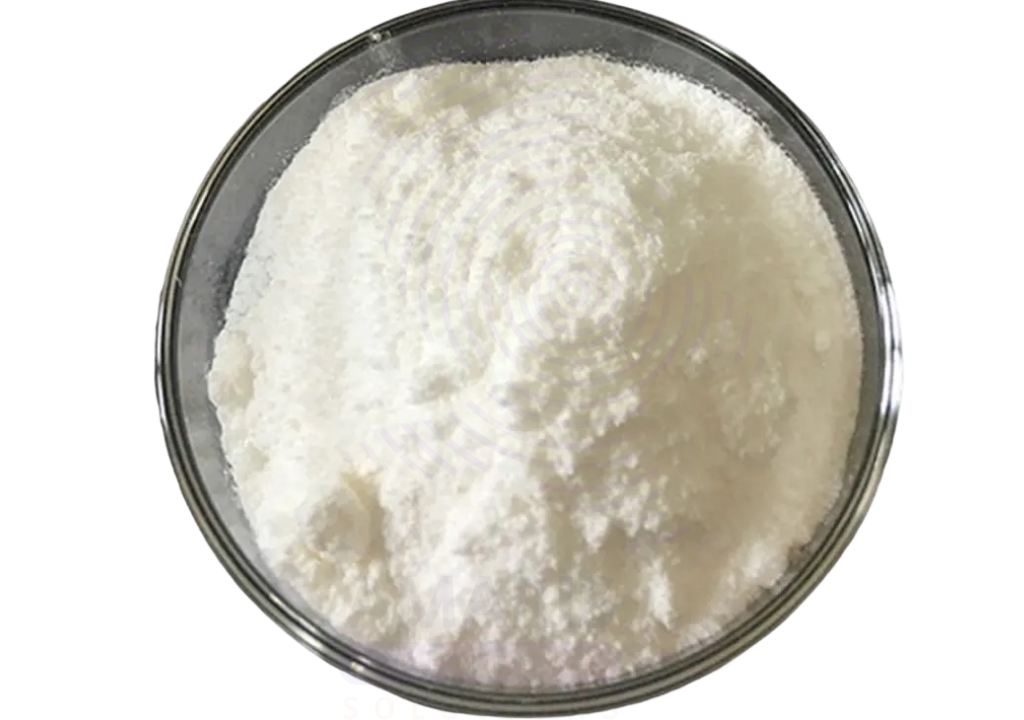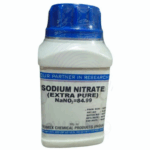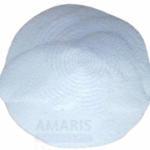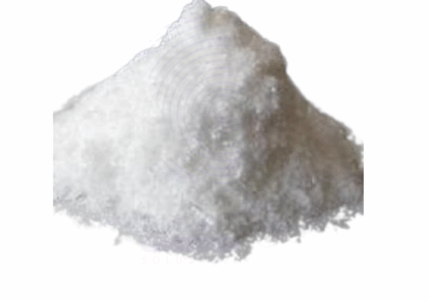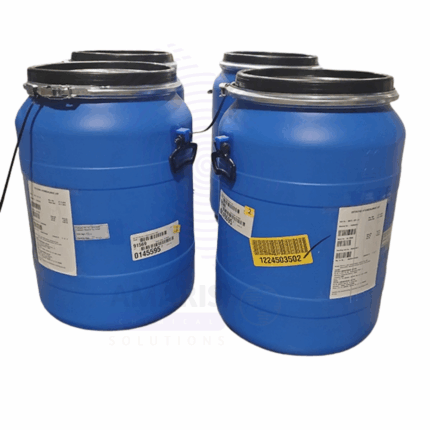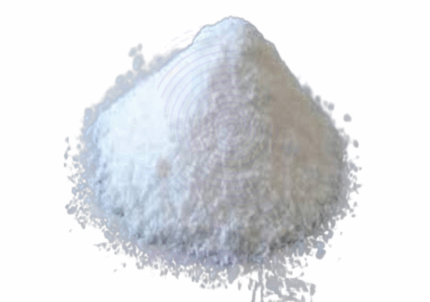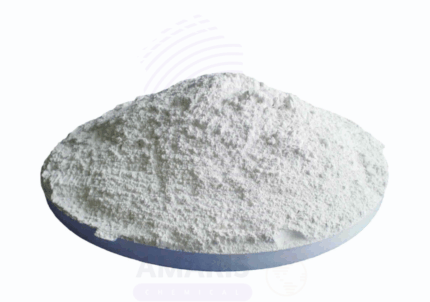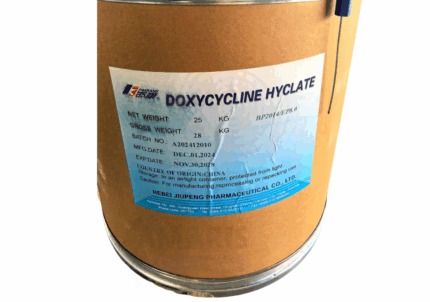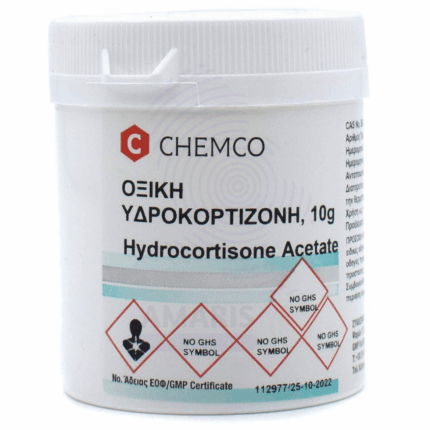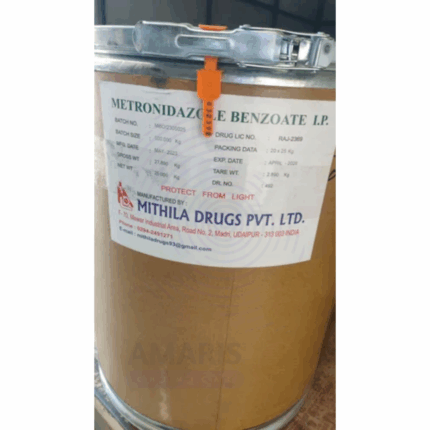Aminosidine Sulphate
$ 3.21 Original price was: $ 3.21.$ 3.09Current price is: $ 3.09.
Aminosidine Sulphate USP, also known as Paromomycin Sulphate, is an aminoglycoside antibiotic primarily used to treat parasitic infections and certain bacterial infections. It is a white or off-white crystalline powder, highly soluble in water, and typically administered orally or topically. It works by inhibiting protein synthesis in susceptible microorganisms, thereby exerting a bactericidal and antiparasitic effect. Aminosidine Sulphate is commonly employed in treating intestinal amoebiasis, leishmaniasis, and infections caused by gram-negative bacteria. Its inclusion in the United States Pharmacopeia (USP) signifies compliance with strict quality and purity standards for pharmaceutical use.
Aminosidine Sulphate
Primary Uses
- Pharmaceutical & Medical Applications
- Used as an oral antibiotic for treating intestinal parasitic infections such as amoebiasis and giardiasis.
- Administered in the treatment of visceral and cutaneous leishmaniasis, especially in endemic regions.
- Utilized to treat certain bacterial infections caused by gram-negative bacteria, including those resistant to other antibiotics.
- Used topically in some formulations to treat bacterial infections of the skin and mucous membranes.
- Veterinary Medicine
- Used to treat parasitic infections in animals, particularly protozoal infections affecting the gastrointestinal tract.
Secondary Uses
- Research & Laboratory Use
- Employed in microbiological and pharmacological studies related to aminoglycoside antibiotics.
- Occasionally used as a model drug in drug delivery and resistance mechanism research.
- Formulations & Compounded Medications
- Incorporated into combination therapies with other antibiotics or antiparasitic agents for enhanced efficacy.
- Sometimes used in veterinary topical ointments or sprays for local infections.
| PACK SIZE |
25kg |
|---|
1. Basic Identification Attributes
- Chemical Name (IUPAC): (2R,3R,4R,5S,6R)-5-Amino-6-[(1R,2R,3R,4R,5S)-4,5-diamino-2-hydroxycyclohexyl]oxy-2-(hydroxymethyl)oxane-3,4-diol sulfate
- Common/Trade Names: Aminosidine Sulphate, Paromomycin Sulphate
- CAS Number: 1263-89-4
- HS Code: 2941.90.90
- Molecular Formula: C23H46N4O14·H2SO4
- Synonyms: Paromomycin Sulphate, Aminosidine Sulfate USP
2. Physical & Chemical Properties
- Physical State: White to off-white crystalline powder
- Color & Odor: White, odorless or faint odor
- Melting Point: >230°C (decomposes)
- Boiling Point: N/A (decomposes)
- Density: ~1.6 g/cm³
- Solubility: Highly soluble in water; practically insoluble in ethanol and organic solvents
- pH Level: Slightly acidic to neutral in aqueous solution (~4.5–7)
- Vapor Pressure: Negligible
- Flash Point: Not applicable
- Autoignition Temperature: N/A
3. Safety & Hazard Attributes
- Hazard Class (GHS): Harmful if swallowed; may cause allergic skin reactions
- NFPA Ratings: Health 2, Flammability 0, Reactivity 0
- Exposure Limits: No established OSHA PEL; handle as pharmaceutical chemical
- Reactivity: Stable under normal conditions
- Incompatibilities: Strong oxidizers, acids, and bases
4. Storage & Handling Attributes
- Storage Conditions: Store in a cool, dry place below 25°C, protected from moisture and light
- Container Type: Sealed amber glass or plastic containers
- Shelf Life: Typically 2-3 years under proper storage
- Special Handling: Avoid inhalation, skin, and eye contact; use protective gloves and eyewear
5. Regulatory & Compliance Attributes
- Regulatory Status: Listed in USP, approved for pharmaceutical use in many countries
- Transportation: Not classified as hazardous for transport when properly packaged
- Waste Disposal: Dispose of in compliance with pharmaceutical waste regulations
6. Environmental & Health Impact
- Ecotoxicity: Low environmental toxicity; avoid release into waterways
- Persistence: Biodegradable under environmental conditions
- Carcinogenicity: No known carcinogenic effects
- Biodegradability: Readily biodegradable
Safety Handling Precautions
- PPE: Wear gloves, safety goggles, and protective clothing when handling powder or concentrated solutions.
- Handling: Avoid inhalation of dust and direct skin or eye contact; use in a well-ventilated area or fume hood.
- Storage: Keep container tightly closed; protect from moisture and heat.
- Hygiene: Wash hands thoroughly after handling; avoid eating, drinking, or smoking during handling.
First Aid Measures
- Inhalation: Move affected person to fresh air. Seek medical attention if breathing difficulty occurs.
- Skin Contact: Wash skin thoroughly with soap and water. If irritation or allergic reaction develops, seek medical advice.
- Eye Contact: Rinse eyes immediately with plenty of water for at least 15 minutes. Seek medical help if irritation persists.
- Ingestion: Rinse mouth; do not induce vomiting unless directed by medical personnel. Seek immediate medical attention.
Firefighting Measures
- Fire Hazards: Not flammable but may decompose under intense heat producing toxic fumes.
- Extinguishing Media: Use water spray, foam, dry chemical, or CO₂ extinguisher.
- Precautions: Firefighters should use self-contained breathing apparatus due to potential hazardous decomposition products.
Related products
Carbocisteine AJI 92
Cetirizine Dihydrochloride
Chloramphenicol Palmitate Micronised
Diloxanide Furoate
Doxycycline Hyclate BP
Hydrocortisone Acetate
Metronidazole Benzoate BP
Miconazole Nitrate BP
Miconazole Nitrate BP is a high-purity, pharmaceutical-grade antifungal agent conforming to British Pharmacopoeia (BP) specifications. It is widely used in the formulation of topical and oral pharmaceutical products for the treatment of fungal infections caused by dermatophytes and yeasts, including Candida species. Miconazole Nitrate functions by inhibiting the biosynthesis of ergosterol, a vital component of fungal cell membranes, leading to cell death.
This white to off-white crystalline powder is highly effective and exhibits broad-spectrum antifungal and some antibacterial activity. It is commonly utilized in creams, ointments, powders, and gel formulations.


 Preservatives(food)
Preservatives(food) Flavor Enhancers
Flavor Enhancers Acidulants
Acidulants Sweeteners
Sweeteners Antioxidants
Antioxidants Colorants(food)
Colorants(food) Nutraceutical Ingredients (food)
Nutraceutical Ingredients (food) Nutrient Supplements
Nutrient Supplements Emulsifiers
Emulsifiers
 Collectors
Collectors Dust Suppressants
Dust Suppressants Explosives and Blasting Agents
Explosives and Blasting Agents Flocculants and Coagulants
Flocculants and Coagulants Frothers
Frothers Leaching Agents
Leaching Agents pH Modifiers
pH Modifiers Precious Metal Extraction Agents
Precious Metal Extraction Agents
 Antioxidants(plastic)
Antioxidants(plastic) Colorants (Pigments, Dyes)
Colorants (Pigments, Dyes) Fillers and Reinforcements
Fillers and Reinforcements Flame Retardants
Flame Retardants Monomers
Monomers Plasticizers
Plasticizers Polymerization Initiators
Polymerization Initiators Stabilizers (UV, Heat)
Stabilizers (UV, Heat)
 Antifoaming Agents
Antifoaming Agents Chelating Agents
Chelating Agents Coagulants and Flocculants
Coagulants and Flocculants Corrosion Inhibitors
Corrosion Inhibitors Disinfectants and Biocides
Disinfectants and Biocides Oxidizing Agents
Oxidizing Agents pH Adjusters
pH Adjusters Scale Inhibitors( water)
Scale Inhibitors( water)
 Antioxidants(cosmetic)
Antioxidants(cosmetic) Emollients
Emollients Fragrances and Essential Oils
Fragrances and Essential Oils Humectants
Humectants Preservatives
Preservatives Surfactants(cosmetic)
Surfactants(cosmetic) Thickeners
Thickeners UV Filters
UV Filters
 Fertilizers
Fertilizers Soil Conditioners
Soil Conditioners Plant Growth Regulators
Plant Growth Regulators Animal Feed Additives
Animal Feed Additives Biostimulants
Biostimulants Pesticides (Herbicides, Insecticides, Fungicides)
Pesticides (Herbicides, Insecticides, Fungicides)
 Active Pharmaceutical Ingredients (APIs)
Active Pharmaceutical Ingredients (APIs) Excipients
Excipients Solvents(pharmaceutical)
Solvents(pharmaceutical) Antibiotics
Antibiotics Antiseptics and Disinfectants
Antiseptics and Disinfectants Vaccine Adjuvants
Vaccine Adjuvants Nutraceutical Ingredients (pharmaceutical)
Nutraceutical Ingredients (pharmaceutical) Analgesics & Antipyretics
Analgesics & Antipyretics
 Analytical Reagents
Analytical Reagents Solvents(lab)
Solvents(lab) Chromatography Chemicals
Chromatography Chemicals Spectroscopy Reagents
Spectroscopy Reagents microbiology-and-cell-culture-reagents
microbiology-and-cell-culture-reagents Molecular Biology Reagents
Molecular Biology Reagents Biochemical Reagents
Biochemical Reagents Inorganic and Organic Standards
Inorganic and Organic Standards Laboratory Safety Chemicals
Laboratory Safety Chemicals Specialty Laboratory Chemicals(Special Laboratory Equipment)
Specialty Laboratory Chemicals(Special Laboratory Equipment)
 Demulsifiers
Demulsifiers Hydraulic Fracturing Fluids
Hydraulic Fracturing Fluids Scale Inhibitors(oil)
Scale Inhibitors(oil) Surfactants(oil)
Surfactants(oil) Drilling Fluids
Drilling Fluids
 Dyes and Pigments
Dyes and Pigments Bleaching Agents
Bleaching Agents Softening Agents
Softening Agents Finishing Agents
Finishing Agents Antistatic Agents
Antistatic Agents
 Admixtures
Admixtures Waterproofing Agents
Waterproofing Agents Sealants and Adhesives
Sealants and Adhesives Curing Compounds
Curing Compounds Concrete Repair Chemicals
Concrete Repair Chemicals Anti-Corrosion Coatings
Anti-Corrosion Coatings
 Surfactants(cleaning)
Surfactants(cleaning) Builders
Builders Enzymes
Enzymes Solvents (Cleaning)
Solvents (Cleaning) Fragrances
Fragrances
 Electronic Chemicals
Electronic Chemicals Catalysts
Catalysts Lubricants
Lubricants Photographic Chemicals
Photographic Chemicals Refrigerants
Refrigerants Automotive chemicals
Automotive chemicals Pyrotechnic Chemicals
Pyrotechnic Chemicals
 Biodegradable Surfactants
Biodegradable Surfactants Bio-based Solvents
Bio-based Solvents Renewable Polymers
Renewable Polymers Carbon Capture Chemicals
Carbon Capture Chemicals Wastewater Treatment Chemicals
Wastewater Treatment Chemicals
 Pigments
Pigments Solvents(paint)
Solvents(paint) Specialty Coatings
Specialty Coatings Binders/Resins
Binders/Resins Additives
Additives Driers
Driers Anti-Corrosion Agents
Anti-Corrosion Agents Functional Coatings
Functional Coatings Application-Specific Coatings
Application-Specific Coatings
 Fresh Herbs
Fresh Herbs Ground Spices
Ground Spices Whole Spices
Whole Spices Spice Blends
Spice Blends Dried Herbs
Dried Herbs
 Leavening Agents
Leavening Agents Dough Conditioners
Dough Conditioners Flour Treatments
Flour Treatments Fat Replacers
Fat Replacers Decoratives
Decoratives Preservatives(baking)
Preservatives(baking)
 Plasticizers & Softeners
Plasticizers & Softeners Reinforcing Agents
Reinforcing Agents Adhesion Promoters
Adhesion Promoters Vulcanizing Agents
Vulcanizing Agents Antidegradants
Antidegradants Blowing Agents
Blowing Agents Fillers & Extenders
Fillers & Extenders Accelerators & Retarders
Accelerators & Retarders